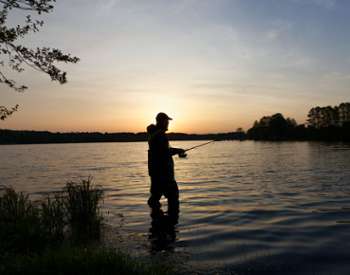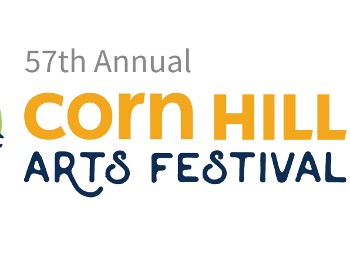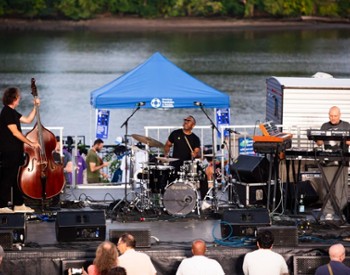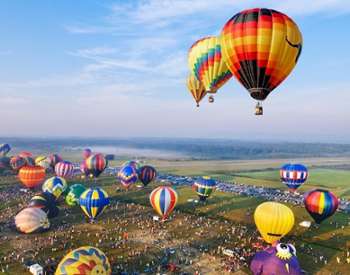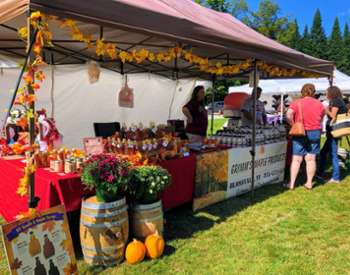Explore History In New York's Capital Region At These Museums & Historical Sites
In the Northeastern U.S. it doesn't get much more historic than New York's Capital Region, namely Albany, which was first inhabited by Algonquian Indian tribes such as the Mohican and the Iroquois, then claimed for the Dutch by Henry Hudson in 1609. Fur traders established Albany's first European settlement in 1614, it was officially chartered as a city in 1686, and it became the capital of New York in 1797. It is one of the oldest surviving settlements from the original 13 colonies, and the longest continuously chartered city in the U.S.
Today, visitors can spend endless hours touring the Capital Region's many museums, historic sites, parks, churches, and theaters. Venturing further north there's also the Saratoga/Schuylerville area, site of the turning point of the American Revolution, as well as the 19th- and 20th-century boom that made Saratoga Springs a must-visit destination for health buffs and horseracing fans alike. Its heritage is remarkably preserved and available to all.
While admittedly, there's enough local history in the area to fill a tome, mandatory historic attractions in the area include:
Saratoga National Historical Park
648 NY-32, Stillwater

In 1777 the American Continental Army under Gen. Horatio Gates defeated and utterly decimated an invading British army led by Gen. John Burgoyne, which had hacked its way south from Canada toward Albany. The Patriot victory is widely considered the turning point in the American Revolution, as the British defeat convinced France to finally join the fight, providing essential aid and naval support to the Americans. Today the expansive four-square-mile battlefield is protected within the grounds of Saratoga National Historical Park, where you can roam the tranquil fields and wooded trails where so many soldiers once gave their lives, stopping at multiple historic spots and skirmish areas within the park. A self-guided car tour provides a great overview, allowing you to drive to each stop, then get out and explore on foot. The park also offers a visitors' center, museum and gift shop, and holds numerous reenactments and living history events throughout the year.
Fort Hardy Park / Field of Grounded Arms
1 Reds St., Schuylerville
Now a fairly unassuming public park and ball field, Fort Hardy Park is the former site of Fort Hardy, built in August 1755 by General Phinehas Lyman at the northwest intersection of the Fish Kill and Hudson River. Named for Sir Charles Hardy, former NY colonial governor, it was intended as a supply post for expeditions against Crown Point. The park also contains the Field of Grounded Arms, where British Gen. Burgoyne and his troops surrendered to Patriot forces and "grounded" their arms on October 17, 1777, officially ending the Battle of Saratoga.
New York State Museum
260 Madison Avenue, Albany

Founded in 1836 and hosting more than 750,000 visitors annually, the New York State Museum is one of the largest cultural and natural history attractions in the state and the oldest state museum in the country. Its collections rank among the finest in many fields, totaling more than 16 million scientific specimens and one million cultural objects. Its 100,000 square feet of exhibit space features approximately 10 new exhibits each year, along with favorites like its full-sized Iroquois longhouse, its early 20th century Spillman carousel, the Cohoes Mastodon, the Adirondack Wilderness display and Fire Engine Hall. The museum also offers a variety of educational public programs for learners of all ages. It is growing, too: The museum is in the midst of a $14 million renovation, which includes adding another 35,000 square feet of future exhibit space.
Johnson Hall State Historic Site
139 Hall Ave., Johnstown
Johnson Hall was the 1763 Georgian-style estate of Irish immigrant Sir William Johnson (1715 - 1774) and Molly Brant, a Mohawk Indian, and their eight children. Johnson was the largest single landowner and most influential colonist in the colonial Mohawk Valley; his strong relations with the Six Nations of the Iroquois greatly aided England's victory over France during the French & Indian War, earning him the title of Baronet, as well as, Superintendent of Indian Affairs. His former 700-acre working estate included gardens, a mill, blacksmith shop, Indian store, barns, slave and servant housing and other essential buildings. Visitors in Johnson's day included members of various Indian tribes, sometimes numbering in the hundreds; today, Johnson Hall welcomes visitors with guided tours of period room settings and of the historic grounds, educational programs, and special events.
New York State Capitol
Washington Avenue and State Street, Albany, NY 12242

Built by hand over the course of 32 years, the New York State Capitol has been the home of New York's government since the 1880s. Visitors can tour this magnificent building and see hand-carved stone and several different types of architecture employed. In addition, Governor Cuomo recently reopened the Capitol's historic Hall of Governors to the public; sweeping renovations were made, including the addition of portraits, informational signs, and a timeline. Exhibits on New York State's history have been installed throughout the building, including 100 Years of Women's Suffrage in New York State and The Hall of New York - Historic Landscapes of Every Region of New York State.
USS Slater DE766
145 Broadway, Albany, NY 12202
A historic WWII Cannon-class destroyer escort, USS Slater DE766 is the only DE still afloat with its original 1945 configuration intact, out of the 563 similar ships constructed between 1943 and 1945 to serve as anti-submarine vessels. During the war the Slater served in both the Atlantic and Pacific Theaters, escorting convoys, conducting shore bombardments and serving as a radar picket ship, among other duties. Now moored on the Hudson River, visitors can tour three levels of the ship, including the galley, mess, crew sleeping quarters, officer's country, captain's private quarters, chart room and pilot house. Overnight camping on the ship is also available.
National Museum of Racing and Hall of Fame
191 Union Ave., Saratoga Springs, NY 12866

Saratoga Springs and horseracing are inextricably linked, making the city the ideal location for the National Museum of Racing and Hall of Fame, which explores three centuries of Thoroughbred racing. It houses a diverse collection of art, artifacts, and memorabilia documenting the social, economic, political and cultural history of Thoroughbred racing in America from the 18th century to the present, including trophies, sculptures, paintings, photographs and works on paper. Other highlights include the horse play! Children's gallery, a large assortment of rare racing and pop culture memorabilia and behind-the-scenes tours of Saratoga's "Oklahoma" training track. The Hall of Fame contains plaques commemorating all 412 members: As of August 2016, there were 206 horses, 103 jockeys, 95 trainers and eight Pillars of the Turf.
Saratoga Race Course
267 Union Ave., Saratoga Springs, NY 12866
No trip to Saratoga Springs is complete without a stop at the world-famous Saratoga Race Course, which has been a staple of the Thoroughbred horseracing circuit since 1863, and site of major racing events like the Travers Stakes, Saratoga's signature race and the nation's oldest major stakes race for 3-year-olds. Daily walking tours are offered, covering more than 150 years of the racetrack's unique history. Also noteworthy is the Saratoga Walk of Fame, recognizing prominent Thoroughbred industry owners, trainers. and jockeys who have left a significant mark on Saratoga.
Saratoga Spa State Park
19 Roosevelt Drive, Saratoga Springs, NY 12866

The Saratoga Springs area has the only active spouting geysers east of the Mississippi River in the U.S., and over the years the ensuing popularity of those springs-which produce carbonated water rich in minerals and salts, purported to have healing properties-gave rise in 1962 to Saratoga Spa State Park. Listed on the National Register of Historic Places, the park contains more than 2,200 acres of public parkland, including the Saratoga Performing Arts Center (popular for concerts and the summer home of the Philadelphia Orchestra and New York City Ballet), the Spa Little Theater, the National Museum of Dance, the Saratoga Automobile Museum, the Gideon Putnam Resort and Roosevelt Baths and Spa, as well as numerous recreation facilities, like its two pool areas, two golf courses and boat launch.
Albany Institute of History & Art
125 Washington Ave., Albany, NY 12210
The Albany Institute of History & Art was founded in 1791, during the presidency of George Washington, making it one of the oldest museums in the U.S. and older than the Louvre, the Smithsonian and the Metropolitan Museum of Art. It is dedicated to collecting, preserving, interpreting and promoting interest in the history, art, and culture of Albany and the Upper Hudson River Valley Region. Although famous for its Hudson River school paintings, its collections include fine arts, furnishings, personal objects, documents, manuscripts, photographs and personal papers used by people of all ages, socio-economic conditions and cultural groups. Long-term exhibitions include: Ancient Egypt, Nineteenth-Century American Sculpture: Erastus Dow Palmer, Launt Thompson, Charles Calverley, and Traders and Culture: Colonial Albany and the Formation of American Identity.
Grant Cottage State Historic Site
1000 Mt McGregor Rd., Wilton, NY 12831

Former Civil War general and U.S. president Ulysses S. Grant lived at Grant Cottage in Wilton with his family, servants, and doctors in 1885, while writing his memoirs, until his death from throat cancer that July 23rd. Today, the cottage remains essentially the same as during the Grant family's stay; visitors tour the downstairs area, viewing original furnishings, decorations and personal items belonging to Grant, including the bed where he died, and floral arrangements from Grant's August 4th funeral. The site also offers lovely views of the Hudson Valley.
National Bottle Museum
76 Milton Ave., Ballston Spa, NY 12020
Millions of glass bottles per year were manufactured by hand for the mineral waters of Saratoga County, including a glassworks in the wilderness above Greenfield that employed hundreds from the 1840s to the 1860s. In that spirit the National Bottle Museum's exhibits, videos and research library interpret the history of 18th and 19th-century bottles; one entire wall of the museum's first floor showcases approximately 2,000 bottles of many colors, shapes, and forms. The museum also has access to collections all over the U.S., making frequent changes and more spectacular exhibits possible. Glassblowing instruction is available to guests with pre-registration.
New York State Military Museum and Research Center
61 Lake Avenue, Saratoga Springs, NY 12866

Located in a historic armory constructed by Isaac Perry in 1889, the museum tells the story of New York's soldiers, from Native American warriors through today, via multiple exhibits and programs, with particular emphasis on the Civil War. The museum houses over 10,000 artifacts, including the largest collection of battle flags in North America and the largest collection of Civil War flags in the world. Notable Civil War artifacts include a uniform worn by Colonel Elmer Ellsworth (the Union's first martyr), the medical kit of Jubal Early's surgeon and the uniform and bugle of Gustav Schurmann, Gen. Philip Kearny's boy bugler. There are also significant holdings relating to New York's 27th Division (WWI & WWII) and notable state military regiments like the 7th (Silk Stocking Regiment), 69th (Fighting Irish), 71st and 369th (Harlem Hell fighters) New York Infantry. The attached Veterans Research Center includes a 2,000-volume library of military and New York State history, over 6,000 photographs, unit history files, broadsides, scrapbooks, letters, and maps.
Schenectady Stockade Area National Historic Landmark
23-29 Front St., Schenectady, NY 12305
New York State's first historic district is one of the few places in the U.S. where a thriving residential community has occupied the same site for more than 300 years. View homes from the early 1700s, including more than 40 pre-Revolutionary houses and architectural styles that include Dutch Colonial, Georgian, Federal and Victorian. The neighborhood is also home to the Schenectady County Historical Society, Riverfront Park, The Stockade Inn and The Van Dyck Restaurant & Lounge. Walking tour information is available at the Historical Society.
Ten Broeck Mansion
9 Ten Broeck Pl., Albany, NY 12210

The headquarters of the Albany County Historical Association, Ten Broeck Mansion is a stunning brick Federal-style home built in 1798 by Gen. Abraham Ten Broeck and his wife Elizabeth Rensselaer, with later Greek Revival enhancements. Tour the historic home and take part in numerous special events held throughout the year. The site also hosts history programs for all ages, including a summer archaeology camp, lectures, and holiday attractions.
Burden Iron Works Museum
1 East Industrial Parkway, Troy, NY 12180
Located in the former office of one of the most important firms in the history of iron and steel, the Burden Iron Works Museum educates visitors not only about the history of ironworking in South Troy, but also about the transformation of the region around the confluence of the Hudson and the Mohawk Rivers into the "Silicon Valley" of the 19th century. Artifacts include Civil War-era armor from the USS Monitor, the first ironclad warship commissioned by the Union Navy.
